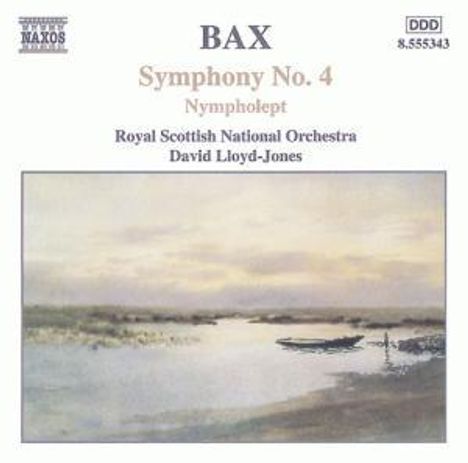Arnold Bax: Symphonie Nr.4 auf CD
Symphonie Nr.4
Herkömmliche CD, die mit allen CD-Playern und Computerlaufwerken, aber auch mit den meisten SACD- oder Multiplayern abspielbar ist.
Lassen Sie sich über unseren eCourier benachrichtigen, falls das Produkt bestellt werden kann.
+Nympholept; Picaresque Comedy Overture
- Künstler:
- Royal Scottish National Orchestra, David David Lloyd-Jones
- Label:
- Naxos
- Aufnahmejahr ca.:
- 2000
- UPC/EAN:
- 0747313534326
- Erscheinungstermin:
- 2.4.2002
Ähnliche Artikel
Bax widmete seine Vierte Symphonie Paul Corder, Sohn und Schüler von Frederick Corder und Mitglied des Bax-Kreises. Das Werk wurde im Februar 1931 in Morar vollendet und ein Jahr später in San Francisco vom San Francisco Symphony Orchestra unter Basil Cameron uraufgeführt.
Der Komponist nahm das Meer als seine Inspiration in Anspruch, bei Flut im Sonnenschein, und erklärte die Symphonie als eine Beschwörung der Natur. Die für drei Holzbläser, sechs Hörner, drei Trompeten und Posaunen, Tenor- und Basstuba, Schlagzeug, Harfe, Celesta, Orgel und Streicher besetzte Sinfonie beginnt mit einem stark ausgeprägten Thema, das durch ein unteres Es der Kontrabässe, Fagotte und Kontrafagott und ein Orgelpedal von 16 Fuß Länge untermauert wird. Das Meer wogt in rapider Weise vorwärts und wieder zurück, was zu einem dritten charakteristischen Element mit schottischem Beigeschmack führt, einem Material, das vor dem Erscheinen einer Oboenmelodie entwickelt wird, begleitet von Klarinetten, gefolgt von einer Flötenmelodie, die von Holzbläsern und vier Solo-Cellos, der zweiten Themengruppe, begleitet wird. Die Entwicklung dieser Ideen beinhaltet ein trällerndes Allegretto semplice, bevor die ursprüngliche Stimmung wieder hergestellt wird. Der langsame Satz enthält, wie Lewis Foreman betont hat, motivische Anspielungen und Erinnerungen an die Klavierromanze von 1918, die für Harriet Cohen geschrieben wurde, jetzt aber vermutlich mit Mary Gleaves assoziiert wird. Die langgezogene Melodie des langsamen E-Dur-Satzes wird von den Holzbläsern eingeleitet, die eine weitere Evokation des Meeres heraufbeschwören, das ruhig und dann immer stärker wird, mit Momenten, die wieder an Schottland und die Westküste zu erinnern scheinen. Das finale Allegro bricht in die letzte Heiterkeit des langsamen Satzes ein, dessen aufwühlender, an Strawinsky erinnernder, Eröffnungssatz einem Marsch und dem Klang entfernter Trompeten weicht. In einer Passage für Holzbläser und Solovioline kommt es zu einer ergreifenden Entspannung, wobei die Oboenmelodie dann von den Celli und den ersten Violinen übernommen wird. Ein Allegro scherzando führt zu einem Flötensolo, das uns sanft an Schottland erinnert, bevor ein abschließender Triumphmarsch die vorhergehenden Ideen zum Schluss zusammenführt.
Product Information
Bax dedicated his Fourth Symphony to Paul Corder, son and pupil of Frederick Corder and a member of the Bax circle. The work was completed at Morar in February 1931 and was first performed a year later in San Francisco by the San Francisco Symphony Orchestra under Basil Cameron.
The composer claimed the sea as his inspiration, at high tide in the sunshine, explaining the symphony as an evocation of nature. Scored for triple woodwind, six horns, three trumpets and trombones, tenor and bass tuba, percussion, harp, celesta, organ and strings, the symphony starts with a strongly marked theme, underpinned by a bottom E flat from the double basses, bassoons and double bassoon and organ 16-foot pedal. The sea surges forward and back again in rapider figuration, leading to a third characteristic element with a Scottish flavour, material that is developed before the appearance of an oboe melody, accompanied by clarinets, followed by a flute melody, accompanied by woodwind and four solo cellos, the second subject group. The development of these ideas includes a lilting Allegretto semplice before the original mood is re-established. The slow movement, as Lewis Foreman has pointed out, contains motivic references and reminiscences of the 1918 piano Romance, written for Harriet Cohen, but now presumably associated with Mary Gleaves. The long-drawn out melody of the E major slow movement is introduced by the woodwind, bringing a further evocation of the sea, still and then mounting in power, with moments that seem again to suggest Scotland and the west coast. The final Allegro bursts into the final serenity of the slow movement, its stirring Stravinskyan opening giving way to a march and the sound of distant trumpets. There is a moving relaxation of tension in a passage for woodwind and solo violin, the oboe melody taken up then by the cellos and by the first violins. An Allegro scherzando leads to a flute solo gently reminding us of Scotland before a final triumphal march that brings the preceding ideas together in conclusion.
Disk 1 von 1 (CD)
-
1 Overture to a Picaresque Comedy
-
2 Nympholept
-
3 Symphony No. 4: I. Allegro moderato
-
4 Symphony No. 4: II. Lento moderato
-
5 Symphony No. 4: Iii. Allegro
Mehr von Arnold Bax
-
Edmund RubbraKlavierkonzert G-Dur op.85CDVorheriger Preis EUR 19,99, reduziert um 0%Aktueller Preis: EUR 9,99
-
Arnold BaxVariationen für Orchester (Improvisationen)Super Audio CDAktueller Preis: EUR 19,99
-
Arnold BaxPhantasy für Viola & OrchesterCDAktueller Preis: EUR 19,99
-
Arnold BaxSymphonie Nr.2CDVorheriger Preis EUR 13,99, reduziert um 0%Aktueller Preis: EUR 12,99










